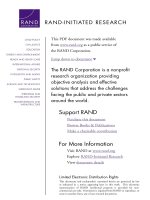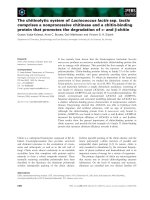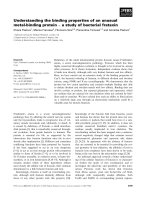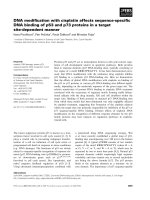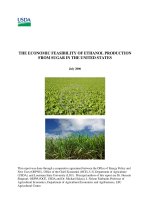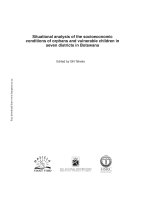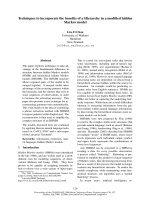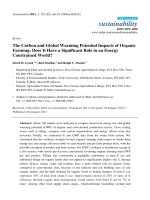The Benefi ts of Biotechnology: Scientifi c Assessments of Agricultural Biotechnology’s Role in a Safer, Healthier World
Bạn đang xem bản rút gọn của tài liệu. Xem và tải ngay bản đầy đủ của tài liệu tại đây (635.15 KB, 28 trang )
The Benefi ts of Biotechnology:
Scientifi c Assessments of Agricultural
Biotechnology’s Role in a Safer, Healthier World.Biotechnology has the
power to increase human
health, environmental
sustainability and the well-
being of consumers and
farm communities globally.
For example, higher yielding crops developed
through agricultural biotechnology can
contribute toward meeting the United Nation’s
estimated need for a 50 percent increase
in world food production by 2030. This
brochure summarizes the United Soybean
Board’s compendium titled “The Benefits of
Biotechnology” available at SoyConnection.com.
Introduction
Crops improved through agricultural biotechnology
have been grown commercially on a commodity scale
for over 12 years. These crops have been adopted
worldwide at rates exceeding any other advances in the
history of agriculture. This report assesses the impact
biotechnology is having on the global agriculture system
from a community, health and environmental perspective.
Impact on the Global Community
Agricultural biotechnology can help solve the global
food crisis and make a positive impact on world hunger.
According to the United Nations, food production
will have to rise by 50 percent by the year 2030 to
meet the demands of a growing population.
Agricultural biotechnology has been shown to multiply crop
production by seven- to tenfold in some developing countries,
far beyond the production capabilities of traditional agriculture,
and the global community is taking notice. In 2007, 12 million
farmers in 23 countries – 12 developing and 11 industrialized
– planted 252 million acres of biotech crops, primarily
soybeans, corn, cotton and canola. Eleven million of these
were small or resource-poor farmers in developing countries.
Farmers earn higher incomes in every country
where biotech crops are grown. When farmers
benefit, their communities benefit as well.
4 • Introduction
Positive Impact on Human Health
Agricultural biotechnology is moving beyond input traits
and is focused on delivering consumer health benefits.
Over 10 new soybean varieties with human health
benefits moving toward commercialization. Beneficial
traits include lower saturated fat, increased omega-3
fatty acids and increased isoflavone content.
Consumers can rest assured that agricultural biotechnology
is safe. These crops have been repeatedly studied and
declared safe by expert panels the world over. In the 12+
years that biotech crops have been commercially grown,
there has not been a single documented case of an
ecosystem disrupted or a person made ill by these foods.
Impact on the Environment
Arguably, the biggest environmental impact of biotech crops
has been the adoption of no-till farming. Herbicide-tolerant
crops like biotech soybeans allowed farmers to almost
completely eliminate plowing on their fields, resulting in better
soil health and conservation, improved water retention/
decreased soil erosion and decreased herbicide runoff. In
fact, no-till farming has led to a global reduction of 14.76
billion kg of carbon dioxide (CO
2
) in 2006, the equivalent of
removing 6.56 million cars from the roads for one year.
Global pesticide applications decreased six percent in the 10
years after biotechnology derived crops were first introduced,
eliminating 379 million pounds of pesticide applications.
Biotechnology derived crops are improving water quality
both through less herbicide and pesticide in runoff
from fields, and in the future also through reducing
phosphorus excretion in livestock by using biotech
derived feed that contains reduced levels of phytate.
Introduction • 5
Biotechnology and the
Global Community
Sustainable Communities
Many scientists would agree that biotechnology is an
important contributor to a sustainable agriculture system
because it can produce more food with a lesser environmental
impact as compared to conventional agriculture.
Soybean Farmers Working
Toward a Sustainable Future
U.S. soybean growers have been committed for many
years to using sustainable production methods to meet
the needs of the present while improving the ability of
future generations to meet their own needs by:
Adopting technology and best practices which
increase productivity to meet future needs
while being stewards of the environment;
Improving human health through
access to safe, nutritious food;
Enhancing the social and economic well
being of agriculture and its communities.
U.S. farmers found that the new biotech herbicide-resistant
soybeans made “no-till” and other conservation tillage
practices much more feasible in more latitudes and on more of
the many different farm soil types in the U.S. from 1996-2001
than ever before. During that time period, use of conservation
tillage in soybean fields approximately doubled, and by 2001,
49 percent of total U.S. soybean hectares were no-till and an
additional 33 percent of total U.S. soybean acres were low-till.
1
6 • Biotechnology and the Global Community
World Hunger
Biotechnology holds great promise for increasing the
world’s food supply and improving the quality of that food.
It is estimated that 800 million people around the world
suffer from chronic food shortages, and millions more could
go hungry due to current and future food crises. Crops
improved through biotechnology are producing higher yields
worldwide to help feed a hungry and growing world.
The UN Calls for Increased
Food Production
United Nations (UN) Secretary General Ban Ki-moon
urged nations to seize an “historic opportunity to revitalize
agriculture” as a way of tackling the food crisis. Mr. Ban told
a UN-sponsored summit in June 2008 in Rome that food
production would have to rise by 50 percent by the year 2030
to meet demand. The UN’s Food and Agriculture Organization
(FAO) has warned industrialized countries that, unless they
increase yields, eliminate trade barriers and move food to
where it is needed most, a global catastrophe could result.
Food prices experienced in 2008 are believed to have
pushed 100 million people into hunger worldwide. And, the
world population continues to increase further straining food
supplies. Currently at 6.7 billion people
2
, the world population
increased from 3 billion in 1959 to 6 billion by 1999, and is
projected to grow to 9 billion by 2040.
3
Poorer countries faced
a 40 percent increase in their food imports bill in 2008.
4
Biotechnology and the Global Community • 7
Crops improved through
biotechnology are producing higher
yields worldwide to help feed a
hungry and growing world.
The UN FAO acknowledges that biotechnology provides
powerful tools for the sustainable development of
agriculture to help meet the food needs of a growing
population. At the same time, the FAO calls for a cautious,
case-by-case approach to determine the benefits and
risks of each individual biotech crop genetic event and
to address the “legitimate concerns for the biosafety
of each product and process prior to its release.”
5
Rising Food Costs
Prices of agricultural food commodities have risen considerably
during the past few years. Among the contributing factors
are low levels of world stocks for some crops, below average
harvests and crop failures in some places. When food prices
rise, the poorest consumers are often the first to suffer.
As a result of earlier years of low food prices, investment
in agriculture has declined and many poor countries are
increasingly dependent on imports to meet their food needs.
6
World Population 1950-2040
Source: U.S. Census Bureau, International Data Base (IDB), 2008
10
8
6
4
2
0
1950 1960 1970 1980 1990 2000 2010 2020 2030
2040
World Population (Billions)
Year
10
8
6
4
2
0
1950 1960 1970 1980 1990 2000 2010 2020 2030
2040
World Population (Billions)
Year
According to the UN FAO, this economic climate has
created a serious risk that fewer people will be able
to get food, especially in the developing world. The
agency’s food price index rose by more than 40 percent
over one year, a rate more than four times higher than is
considered acceptable. The total cost of food imported
by the neediest countries rose 25 percent in 2007.
7
Some Blame African Hunger on Rejection
of Agricultural Biotechnology
According to the Financial Times, as world food prices surge
and shortages loom, biotech crops are increasingly seen as
a way to raise agricultural yields without using more energy
or chemicals. In Europe, where agricultural biotechnology
has faced the strongest public resistance, more politicians,
experts and farmers’ leaders are speaking out in its favor. Sir
David King, the United Kingdom (UK) government’s former
chief scientist, is one who says biotechnology is the only
technology available to solve the world food price crisis.
8
During a 2008 speech, King criticized non-governmental
organizations and the UN for backing traditional farming
techniques, which he insists cannot provide enough food for
the African continent’s growing population. “The problem is
that the western world’s move toward organic farming - a
lifestyle choice for a community with surplus food - and
against agricultural technology in general and GM in particular,
has been adopted across the whole of Africa, with the
exception of South Africa, with devastating consequences.”
9
King has also said that biotech crops could help Africa mirror
the substantial increases in crop production seen in India
and China. He noted that modern agricultural technologies
can multiply crop production per hectare by factors of
seven to 10 and that traditional techniques could “not
deliver the food for the burgeoning population of Africa.”
10
Biotechnology and the Global Community • 9
World Leaders Recognize the
Benefits of Biotechnology
The G8 leaders, at their annual summit in July 2008,
agreed to work to increase global agricultural yields
by providing farmers with greater access to seed
varieties developed through biotechnology.
The G8 leaders decided to increase global agricultural
yields by providing greater access to seeds developed
through biotechnology. The group decided that they would
“accelerate research and development and increase access
to new agricultural technologies to boost agricultural
production” in an effort to help address food security
and poverty. In addition, they said they would “promote
science-based risk analysis including on the contribution
of seed varieties developed through biotechnology.” They
also agreed to form a global partnership on agriculture
and food, which would include the governments of
developing countries, the private sector, civil society
groups, international donors and multilateral institutions.
11
Growth in Biotech Plantings
Helps Feed a Hungry World
In 2007, 12 million farmers in 23 countries – 12 developing
and 11 industrialized – planted 252 million acres of biotech
crops, primarily soybeans, corn, cotton and canola. Eleven
million of these farmers were small or resource-poor
farmers in developing countries.
12
The size of the farm
has not been a factor affecting use of the technology.
10 • Biotechnology and the Global Community
Biotechnology Provides Farmer
and Community Benefits
The world’s farmers are not the only beneficiaries of
agricultural biotechnology. When the farmer benefits, the
local community benefits economically, and the consumers
in that community also benefit with a safe, nutritious and
sustainable food supply. For example, in Argentina, the
economic gains resulting from a 140 percent increase in
soybean area since 1995 are estimated to have contributed
towards the creation of 200,000 additional agriculture-
related jobs and export-led economic growth.
13
Increased Production and Plantings
Since the first commercialized crop in 1996, the world’s
farmers have consistently increased their plantings of
biotech crops by double-digit growth rates every year.
The increase of 12 million hectares between 2005 and
2006 was the second highest in the last five years and
equivalent to an annual growth rate of 13 percent in 2006.
The global area of approved biotech crops in 2006 was
102 million hectares.
14
Biotechnology helped increase U.S.
agricultural production yields by 8.34 billion pounds of
corn and soybeans on 123 million acres in 2005.
15
Biotech
plants that resist pests and diseases, tolerate harsh growing
conditions and reduce spoilage prevent farmers from losing
billions of pounds of important food crops annually.
Biotechnology and the Global Community • 11
Biotech plants that resist pests
and diseases, tolerate harsh
growing conditions and reduce
spoilage prevent farmers from
losing billions of pounds of
important food crops annually.
Increased Farmer Income
Farmers earn higher incomes in every country where biotech
crops are grown. Worldwide, conservative estimates indicate
biotech crops increased farmer income by $4.8-6.5 billion
in 2004, part of a cumulative gain of $19-27 billion between
1996 and 2004.
16
It is noteworthy that farmers in developing
countries captured the majority of the extra farm income
from biotech crops. The largest gains in farm income have
been in the soybean sector, largely from cost savings. For
example, the $3 billion additional income generated by
herbicide-tolerant biotech soybeans in 2006 was equivalent
to adding 6.7 percent to the value of the crop in the biotech-
growing countries or adding the equivalent of 5.6 percent to
the $55 billion value of the global soybean crop in 2006.
17
Cost Savings from Decreased
Pesticide/Herbicide Use
Biotech crops decreased U.S. farmer’s production costs
by $1.4 billion in 2005, contributing to an increase in net
profits of $2 billion that year.
18
For soybeans specifically,
farmers save an estimated $73/hectacre in reduced input
costs.
19
Because small farms around the world are hampered
by the same pests, international farming communities
benefit when U.S. farmers are able to save on pesticide/
herbicide costs and reinvest their funds into technology
improvements. Increased productivity is a benefit to any
farmer, but tremendously enhances quality of life when a
small-scale farmer can escape from subsistence farming.
12 • Biotechnology and the Global Community
Biotechnology and
Human Health
The benefits of biotechnology reach far beyond environmental
and farmer benefits. Consumers are already benefiting
with healthier foods, and those benefits are expected
to grow significantly. Consumers will soon see biotech
crops that are nutrient-enhanced, and in the case of
soybeans, a variety of health benefits stemming from
enhanced protein and oil content. Ensuring consumer
safety is paramount throughout all product introductions.
Safety
Most foods we eat today come from plants or animals
that farmers have “genetically modified” through centuries
of conventional breeding.
20
Plants and animal species
have been crossbred to develop useful new varieties with
beneficial traits, such as better taste or increased productivity.
Traditional crossbreeding also produces changes in the
genetic makeup of a plant or animal. Modern agricultural
biotechnology techniques are different and substantially
improved from traditional crossbreeding because they allow
for more precise development of crop and livestock varieties.
In the 12+ years that biotech crops have been commercially
grown, there has not been a single documented case of an
ecosystem disrupted or a person made ill by these foods.
In the U.S., new foods produced through conventional
breeding or introduced into the marketplace from other
parts of the world where they have been widely consumed
are not required to undergo exhaustive safety assessments.
They are assumed to be safe because they are similar to
other varieties or because they have been safely consumed
elsewhere in the world. On the other hand, products
derived through agricultural biotechnology are exhaustively
assessed for safety before their introduction into the food
marketplace. This means that the safety assessment of
foods derived through biotechnology has actually been much
more stringent than for conventionally derived products.
21
Biotechnology and Human Health • 13
Experts Agree, Biotechnology is Safe
National Academy of Sciences
(NAS) Statement on Safety
The National Academy of Sciences (NAS) published a
landmark white paper in 1987 on the introduction of
organisms derived through agricultural biotechnology. This
white paper has had significant impact in the U.S. and
other countries. Its most significant conclusions include: (1)
There is no evidence of the existence of unique hazards,
either in the use of rDNA biotechnology techniques or in
the movement of genes between unrelated organisms,
and (2) Any risks associated with the introduction of
biotechnology-derived organisms are the same in kind
as those associated with the introduction of unmodified
organisms and organisms modified by other methods.
UK’s House of Lords Statement on Safety
The UK’s House of Lords Select Committee on Science
and Technology released a similar position. “As a matter
of principle, GMO-derived products [i.e., those from
genetically manipulated organisms, or recombinant
organisms] should be regulated according to the same
criteria as any other product…UK regulation of the new
biotechnology of genetic modification is excessively
precautionary, obsolescent, and unscientific. The resulting
bureaucracy, cost, and delay impose an unnecessary
burden to academic researchers and industry alike.”
22
14 • Biotechnology and Human Health
In the 12+ years that biotech
crops have been commercially
grown, there has not been a single
documented case of an ecosystem
disrupted or a person made ill by
these foods.
United Nations/World Health
Organization Statements on Safety
In 1991, the first of three joint UN FAO/World Health
Organization (WHO) consultations concluded: “Biotechnology
has a long history of use in food production and processing.
It represents a continuum embracing both traditional breeding
techniques and the latest techniques based on molecular
biology. The newer biotechnological techniques, in particular,
open up very great possibilities of rapidly improving the
quantity and quality of food available. The use of these
techniques does not result in food which is inherently
less safe than that produced by conventional ones.”
23
In 1996, the second UN FAO/WHO consultation came to the
same conclusions as the first: “Food safety considerations
regarding organisms produced by techniques that change
the heritable traits of an organism, such as rDNA technology,
are basically of the same nature as those that might arise
from other ways of altering the genome of an organism, such
as conventional breeding…While there may be limitations
to the application of the substantial equivalence approach
to safety assessment, this approach provides equal or
increased assurance of the safety of food products derived
from genetically modified organisms as compared to foods
or food components derived by conventional methods.”
24
In 2000, the third concluded: “A comparative approach
focusing on the determination of similarities and differences
between the genetically modified food and its conventional
counterpart aids in the identification of potential safety and
nutritional issues and is considered the most appropriate
strategy…The Consultation was of the view that there were
presently no alternative strategies that would provide better
assurance of safety for genetically modified foods than the
appropriate use of the concept of substantial equivalence.”
25
Biotechnology and Human Health • 15
European Commission’s Joint Research
Centre Statement on Safety
In 2008, the European Commission’s Joint Research
Centre reconfirmed the results of a 2001 Commission study
concluding that no demonstration of any health effect of
biotech food products has ever been reported and the
use of more precise technology and the greater regulatory
scrutiny very likely makes them even safer than conventional
plants and foods.
26
Specifically, the report noted, “There is a
comprehensive body of knowledge that already adequately
addresses current food safety issues including those
dealing with GM products; it is considered by the experts as
sufficient to assess the safety of present GM products.”
27
Biotechnology Provides
Nutritional Benefits
Since the early efforts of biotechnology, scientists have
planned to use the technology to make more nutritious foods
to benefit consumers around the world. As the technology
developed, the first generation of agricultural biotechnology
products were focused more on input traits, which means
these modifications made insect, virus and weed control easier
or more efficient for farmers. These first products have been
rapidly adopted by U.S. farmers, and now account for the
majority of soybeans, cotton and corn grown in the U.S.
28
Agricultural biotechnology varieties focused on consumer
benefits are often called output traits. These products spent
much more time in development, but are moving towards
commercial availability. Many of these would fit into the
category of “functional foods” because they provide added
nutrition compared to their conventional counterparts.
16 • Biotechnology and Human Health
Increased Oleic Acid Soybeans
Creating more stable frying oils can eliminate the need for
hydrogenation, the process that often introduces trans fat.
Therefore, the use of agricultural biotechnology to develop
soybean oils for the food industry with increased levels of
oleic acid for oxidative stability can translate into a consumer
benefit of food products with zero grams of trans fat.
High Isoflavone Soybeans
A wide body of research indicates multiple health benefits of
consuming soy, including: alleviating menopausal symptoms
29
30
, reducing cardiovascular disease risk
31
32
, reducing risk
of certain cancers
33
34
35
and increasing the bone density
of postmenopausal women
36
37
. Soyfoods are the only
natural dietary source of isoflavones, a phytoestrogen that
may be responsible for many of these health benefits. A
soybean with increased isoflavones content could deliver
more of the associated health benefits without consumer
populations needing to remarkably increase their soy intake.
Conjugated Linoleic Acid Soybeans
Conjugated linoleic acid (CLA) has several benefits for
human health including reduced body fat,
38
improved
serum lipid profiles and decreased aortic lipid deposition,
all of which have cardiovascular benefits.
39
Low Phytate Soybeans
Iron deficiency anemia is one of the most widespread
nutritional deficiencies in the world. Absorption inhibitors
such as phytate, a phosphorus storage compound found
in the seeds of many edible crops including soybeans,
may contribute to iron deficiency anemia. New varieties
of soybeans are currently being developed that will offer
50 percent more iron bioavailability from the diet.
Biotechnology and Human Health • 17
Increased Omega-3 Soybeans
Researchers are developing soybeans even richer in omega-3
content, with greater bioavailability. The goal of these enriched
soybeans is to create an affordable, land-based, renewable
source of omega-3s that can be used as an alternative to fish
to create great-tasting foods rich in this essential nutrient.
High Stearic Acid Soybeans
Saturated fatty acids provide important functional properties
to edible fats and oils because they are more stable to heat
and processing than unsaturated fatty acids. However,
saturated fats are known to negatively impact cardiovascular
health. Biotechnology has been used with soybeans to
produce oil enriched in stearic acid, a saturated fatty acid
that scientists believe does not raise serum cholesterol
levels. Preliminary results suggest not all saturated fats are
created equal, and biotech products higher in stearic acid
could provide viable, healthier options for the food industry.
High Beta-Conglycinin Soybeans
Researchers are working to develop a new high beta-
conglycinin soybean, which will provide soy protein with better
taste, texture and ability to blend with foods. Beta-conglycinin
is a naturally occurring, texture- and flavor-improving
compound. The new soybean variety will also contain more
soluble protein than any other soy protein on the market.
40
18 • Biotechnology and Human Health
Biotechnology
and Environmental
Sustainability
Farmers live off the land, and so they take their environmental
stewardship very seriously. Agricultural biotechnology helps
farmers provide a sustainable future for the world’s agriculture
systems. Extensive and repeated studies continue to verify
that biotechnology derived crops pose no risks to the
environment unique or different from conventionally developed
crops. In fact, these studies show that biotechnology
significantly reduces agriculture’s impact to the environment.
Reduced Pesticide Use
Biotechnology provides targeted pest control methods
that are dramatically reducing impacts on non-target
species. In 2005, biotech varieties markedly reduced
farmers’ needs to use pesticide applications, eliminating
69.7 million pounds of pesticide use in the U.S. alone.
41
Globally, it is estimated that pesticide applications
decreased six percent in the interval from 1996 to 2004,
eliminating 379 million pounds of pesticide applications.
42
Soil Management and Conservation Tillage
Although “no-till” was feasible on a limited number of farmland
soil types and in a limited number of U.S. latitudes prior
to the arrival of biotech crops, the biggest environmental
impact of biotech crops has been the adoption of no-till
farming. No-till was made feasible on many more U.S. soil
types and in many more latitudes by herbicide tolerant
soybeans. In 2006, 89 percent (66.68 million acres) of
U.S. soybean acreage was planted with herbicide-tolerant
varieties. Worldwide, 53 percent of all biotech crops were
herbicide-tolerant soybeans. These biotech varieties enabled
farmers to almost completely eliminate plowing on their
applicable fields, which results in significant benefits in terms
of soil health and conservation, improved water retention/
decreased soil erosion and decreased herbicide runoff.
43
Biotechnology and Environmental Sustainability • 19
Water Quality
Most of the phosphorus in conventional soybeans is
in an indigestible form called phytic acid or phytate.
Monogastric animals such as pigs and poultry do not
have the digestive enzymes to degrade this phytate into
a form of phosphorus that can be utilized. To remedy this
problem, producers add inorganic phosphorus to the diet.
The end result is that excessive phosphorus is excreted
in the manure. This contributes to environmental pollution
when the phosphorus enters streams and waterways.
A gene for production of phytase has been successfully
incorporated into soybean and wheat, and is biologically
active when the plants are used as animal feed.
44
In a study
of broiler chickens, consumption of biotech soybeans
containing phytase led to a 50 percent reduction in
phosphorus excretion compared with a diet supplemented
with an intermediate level of nonphytate phosphorus.
45
Feeding the biotech soybeans resulted in an 11 percent
greater reduction in phosphorus excretion than feeding with
conventional soybeans to which the enzyme is added.
Biotechnology is also being used in the development of
low phytate soybeans and corn by silencing the phytate
gene in the seeds.
46
The resulting animal feed will allow
livestock producers to save money they would have spent
on dietary supplements and it will also reduce phosphorus
pollution and improve water quality. The new soybean seed
is expected to be commercially available in the next decade.
20 • Biotechnology and Environmental Sustainability
Agricultural biotechnology helps
farmers provide a sustainable future
for the world’s agriculture systems.
Reduced Greenhouse Gasses
No-till farming reduces the use of agricultural machinery
in fields, which leads to a significant reduction in
greenhouse emissions from farm equipment. In fact,
crops derived from agricultural biotechnology resulted
in a significant reduction in the emission of carbon
dioxide (CO
2
) into the environment. This reduction in CO
2
emissions with biotech crops comes from two sources:
Reduction in the use of diesel fuel in biotech
crops, due to a reduction in pesticide spray
applications and a reduction in plowing.
An increase in the amount of carbon held
in the soil due to a reduction in plowing
associated with biotech crops.
These two factors contributed to a combined reduction equal
to a 14.76 billion kg of CO
2
in 2006. This is the equivalent of
removing 6.56 million cars from the roads for one year.
47
Gene Flow and Outcrossing Risk
Herbicide tolerant soybeans have limited gene flow
risk to nonbiotech varieties. There are several reasons
for this. Soy self-pollinates, which means it is less
prone to gene flow than crops that cross-pollinate. In
addition, there are no sexually compatible wild relatives
in North America. It is estimated that outcrossing rates
between adjacent plants are two percent or less.
48
Biotechnology and Environmental Sustainability • 21
Pest Resistance
Issuance of formal import approvals for the LIBERTY
LINK™ soybean (resistant to glufosinate-ammonium
herbicides) by all applicable overseas markets means that,
beginning in 2009, U.S. farmers will have the freedom to
rotate between usage of different herbicides on soybean
fields, thereby helping to prevent the arising of glyphosate-
(ROUNDUP™ Agricultural Herbicide)-resistant weeds.
49
50
51
Biodiversity
No-till agriculture maintains soil health, the conservation
of topsoil and moisture content. It also encourages
the growth of habitats that support different varieties
of wildlife. Studies have shown that songbirds have
actually returned to agricultural fields in increasing
numbers as biotech crop acreage has increased.
52
The vastly-increased usage of no-till and other
conservation-tillage production practices facilitated by
biotech herbicide-resistant soybeans has made the U.S.
soybean crop significantly less vulnerable to drought.
53
22 • Biotechnology and Environmental Sustainability
Many scientists would agree that
biotechnology is an important
contributor to a sustainable
agriculture system because it can
produce more food with a lesser
environmental impact as compared
to conventional agriculture.
Conclusion
Biotechnology has the power to increase human
health, environmental sustainability and the well-being
of consumers and farm communities globally.
Higher yielding crops developed through
agricultural biotechnology can contribute
toward meeting the United Nation’s
estimated need for a 50 percent increase
in world food production by 2030.
More nutritious crops developed through
agricultural biotechnology can help consumers
meet specific nutrient needs such as
increasing omega-3 fatty acid consumption
or reducing saturated fat consumption.
These improved crops have been declared safe
repeatedly by the world’s top scientific and
regulatory bodies, so consumers can feel safe
eating foods with biotech-derived ingredients.
Farmers can contribute to sustainable
farm communities by earning higher
incomes for biotech-derived crops.
Better soil health, improved water retention/
decreased soil erosion and decreased herbicide
runoff are resulting from the use of biotechnology.
Agricultural biotechnology is decreasing
CO
2
emissions from farming.
Conclusion • 23
Literature Cited
1 ASA Study Confirms Environmental Benefits of Biotech Soybeans,
November 12. 2001 at and
Nonpoint Source News-Notes, (pub. By EPA) January, 2003, p 16-17.
2 United States Census Bureau, International Database. http://www.
census.gov/ipc/www/idb/worldpopinfo.html (accessed Oct. 5, 2008).
3 Ibid.
4 UN News Center. Secretary-General Ban Ki-moon Rome (Italy)
Address at High-level Conference on World Food Security. United
Nations. />statments_full.asp?statID=255 (accessed Oct. 4, 2008).
5 Food and Agriculture Organization of the United Nations, Statement
on Biotechnology, March 2000, />PRESS_NE/PRESSENG/2000/pren0017.htm (accessed Oct. 5, 2008).
6 Food and Agriculture Organization of the United Nations.
World Food Situation. />wfs-faq/en/ (accessed Oct. 5, 2008).
7 Rosenthal, Elisabeth. 2007. World Food Supply is Shrinking.
New York Times, December 18, imes.
com/2007/12/18/business/worldbusiness/18supply.html.
8 Cookson, Clive. 2008. A time to sow? GM food could
curb the cost of staples. Financial Times, July 10.
9 Sample, Ian. 2008. Hunger in Africa blamed on western
rejection of GM food. The Guardian, September 8.
10 Ibid.
11 Reporter’s Notebook. G8 Leaders Call for Increased Global
Access to Agricultural Biotechnology. Council for Biotechnology
Information. July 2008. />newsandevents/reportersnotebook/0708/index_070908.asp.
12 James, Clive. January 2007. Global Status of Commercialized
Biotech/GM Crops: 2006. International Service for the
Acquisition of Agri-Biotech Applications (ISAAA).
13 Brookes & Barfoot. Global Impact of Biotech Crops: Socio-Economic
and Environmental Effects, 1996-2006. AgBioForum, 11(1): 21-38.
14 Ibid.
15 Sankula, Sujatha. November 2006. Quantification of the Impacts
on U.S. Agriculture of Biotechnology-Derived Crops Planted in
2005. National Center for Food and Agricultural Policy.
16 Brookes, Graham and Peter Barfoot. 2005. GM Crops: The
Global Economic and Environmental Impact - The First Nine
Years 1996-2004. AgBioForum 8 (2&3): 187-196.
17 Brookes & Barfoot, 1996-2006.
18 Excellence Through Stewardship. Agricultural Biotechnology:
Benefits Delivered. ellencethroughstewardship.
org/agbiotech/ (accessed Oct. 4, 2008).
19 Brookes & Barfoot, 1996-2006.
20 Hancock, J.F. 2004. Plant Evolution and the Origin of
Crop Species, second edition. CAB International.
21 Ibid.
22 UK. 1993. Regulation of the United Kingdom biotechnology industry
and global competitiveness. October. United Kingdom’s House
of Lords Select Committee on Science and Technology.
23 FAO/WHO. 1991. Strategies for assessing the safety of foods
produced by biotechnology. Report of a Joint FAO/WHO Expert
Consultation. Food and Agriculture Organization of the United Nations
and World Health Organization. WHO, Geneva, Switzerland.
24 FAO/WHO. 1996. Biotechnology and Food Safety. Report of a Joint FAO/
WHO Expert Consultation. Food and Agriculture Organization of the United
Nations and World Health Organization. WHO, Geneva, Switzerland.
25 FAO/WHO. 2000. Safety aspects of genetically modified foods of plant
origin. Report of a Joint FAO/WHO Expert Consultation on Foods Derived
from Biotechnology. Food and Agriculture Organization of the United
Nations and World Health Organization. WHO, Geneva, Switzerland.
26 Europa Press Release. Biotech Food is Safe: Is Anyone Going to
Tell the Consumer? />EuropaBioPressReleaseJRC%20report110908.pdf (accessed Oct. 15, 2008).
27 European Commission. 2008. Scientific and Technical
Contribution to the development of an overall health strategy
in the area of GMOs. />jrc_20080910_gmo_study_en.pdf (accessed Oct. 6, 2008).
28 Pew Initiative on Food and Biotechnology. 2007. Application of
Biotechnology for Functional Foods. The Pew Cheritable Trusts. http://
www.pewtrusts.org/uploadedFiles/wwwpewtrustsorg/Reports/Food_and_
Biotechnology/PIFB_Functional_Foods.pdf (accessed Oct. 5, 2008).
29 Howes LG, Howes JB, Knight DC. Isoflavone therapy for menopausal
flushes: a systematic review and meta-analysis. Maturitas 2006;55:203-11.
30 Messina M, Hughes C. Efficacy of soyfoods and soybean isoflavone
supplements for alleviating menopausal symptoms is positively
related to initial hot flush frequency. J Med Food 2003;6:1-11.
31 Anderson JW, Johnstone BM, Cook-Newell ME. Meta-analysis of the effects of
soy protein intake on serum lipids. N Engl J Med. 1995 Aug 3;333(5):276-82.
32 Zhan S, Ho SC. Meta-analysis of the effects of soy protein containing
isoflavones on the lipid profile. Am J Clin Nutr 2005;81:397-408.
33 Wood CE, Register TC, Franke AA, Anthony MS, Cline JM.
2006. Dietary soy isoflavones inhibit estrogen effects in the
postmenopausal breast. Cancer Res. 2006 Jan 15;66(2):1241-9.
34 Sarkar FH, Li Y. 2003. Soy isoflavones and cancer
prevention. Cancer Invest. 2003;21(5):744-57.
35 Messina MJ, Wood CE. 2008. Soy isoflavones, estrogen therapy, and
breast cancer risk: analysis and commentary. Nutr J. 2008 Jun 3;7:17.
36 Howes, 2006.
37 Ma DF, Qin LQ, Wang PY, Katoh R. 2008. Soy isoflavone intake inhibits bone
resorption and stimulates bone formation in menopausal women: meta-
analysis of randomized controlled trials. Eur J Clin Nutr 2008, 62:155-161.
